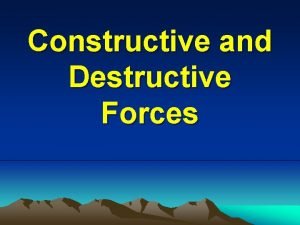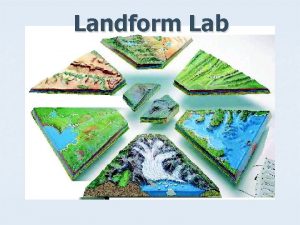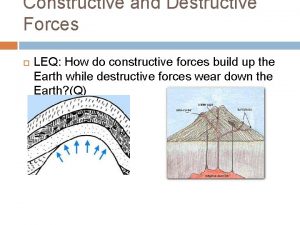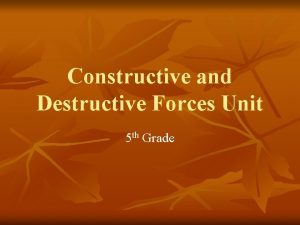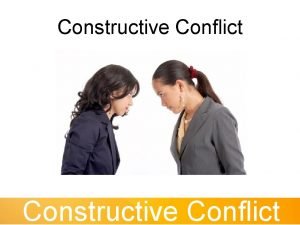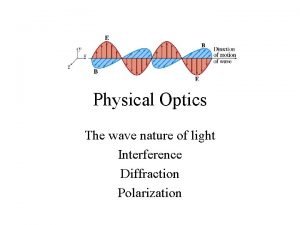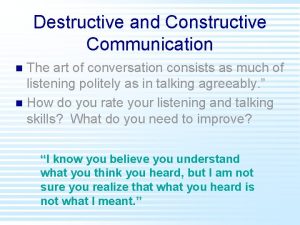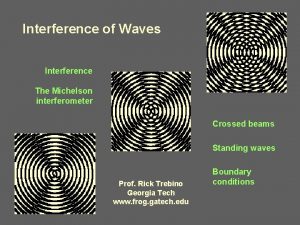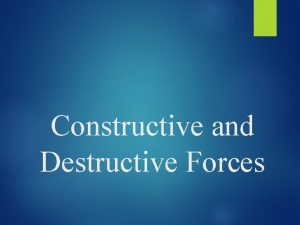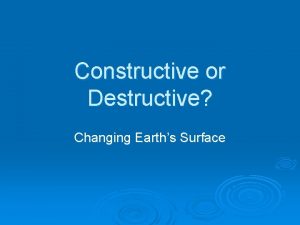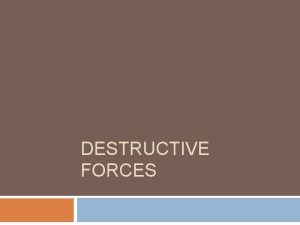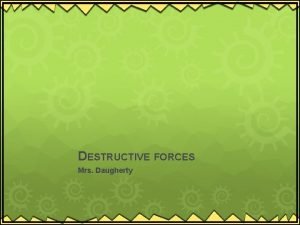Constructive and Destructive Processes Constructive Forces A A











- Slides: 11

Constructive and Destructive Processes

Constructive Forces A. A constructive force is on that build up the Earth’s surface. B. Examples: 1. Mountain building 2. Deposition of sediment n 3. Volcanic Eruption n

August 2006 brought two new things to the Tonga Islands in the South Pacific. One was a raft of lightweight, frothy volcanic rock—pumice— floating on the ocean surface. The other was a new island emerging out of the water.

Constructive Forces


Destructive Force A. A destructive force is one that destroys or breaks down the Earth’s surface. B. Examples: 1. Weathering- a process that causes the breakdown of rock. 2. Erosion- weathering and wearing away of rock into sediment. 3. Deforestation-clearing land of trees 4. Strip mining- clearing land to extract coal or other valuable minerals from the ground.

Destructive Forces- Deforestation n n Deforestation is brought about by the following: conversion of forests and woodlands to agricultural land to feed growing numbers of people; development of cash crops and cattle ranching, both of which earn money for tropical countries; commercial logging (which supplies the world market with woods such as meranti, teak, mahogany and ebony) destroys trees as well as opening up forests for agriculture; felling of trees for firewood and building material; the heavy lopping of foliage for fodder; and heavy browsing of saplings by domestic animals like goats.

CONSEQUENCES OF DEFORESTATION § Carbon Cycle: When forests are cleared, and the trees are either burnt or rot, this carbon is released as CO 2. This leads to an increase in the atmospheric CO 2 concentration. CO 2 is the major contributor to the greenhouse effect. § Water Cycle: With removal of part of the forest, the region cannot hold as much water. The effect of this could be a drier climate. § Soil erosion: With the loss of a protective cover of vegetation more soil is lost. § Silting of water courses, lakes and dams: This occurs as a result of soil erosion. § Extinction of species: which depend on the forest for survival. Forests contain more than half of all species on our planet - as the habitat of these species is destroyed, so the number of species declines. § Desertification: The causes of desertification are complex, but deforestation is one of the contributing factors.

Weathering and Erosion

Strip Mining

Deforestation
 Volcanoes constructive and destructive forces
Volcanoes constructive and destructive forces What are constructive forces?
What are constructive forces? Batholiths and laccoliths
Batholiths and laccoliths Constructive and destructive forces activities
Constructive and destructive forces activities Constructive and destructive forces 5th grade
Constructive and destructive forces 5th grade Constructive and destructive conflict
Constructive and destructive conflict Constructive conflict definition
Constructive conflict definition Apparent frequency formula
Apparent frequency formula What are constructive waves
What are constructive waves Interference
Interference Examples of destructive communication
Examples of destructive communication Michelson interferometer formula
Michelson interferometer formula

